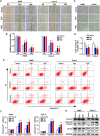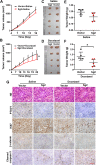Depleting PTOV1 sensitizes non-small cell lung cancer cells to chemotherapy through attenuating cancer stem cell traits
- PMID: 31387622
- PMCID: PMC6685258
- DOI: 10.1186/s13046-019-1349-y
Depleting PTOV1 sensitizes non-small cell lung cancer cells to chemotherapy through attenuating cancer stem cell traits
Abstract
Background: Prostate tumor over expressed gene 1 (PTOV1) has been reported as an oncogene in several human cancers. However, the clinical significance and biological role of PTOV1 remain elusive in non-small cell lung cancer (NSCLC).
Methods: The Cancer Genome Atlas (TCGA) data and NCBI/GEO data mining, western blotting analysis and immunohistochemistry were employed to characterize the expression of PTOV1 in NSCLC cell lines and tissues. The clinical significance of PTOV1 in NSCLC was studied by immunohistochemistry statistical analysis and Kaplan-Meier Plotter database mining. A series of in-vivo and in-vitro assays, including colony formation, CCK-8 assays, flow cytometry, wound healing, trans-well assay, tumor sphere formation, quantitative PCR, gene set enrichment analysis (GSEA), immunostaining and xenografts tumor model, were performed to demonstrate the effects of PTOV1 on chemosensitivity of NSCLC cells and the underlying mechanisms.
Results: PTOV1 is overexpressed in NSCLC cell lines and tissues. High PTOV1 level indicates a short survival time and poor response to chemotherapy of NSCLC patients. Depleting PTOV1 increased sensitivity to chemotherapy drugs cisplatin and docetaxel by increasing cell apoptosis, inhibiting cell migration and invasion. Our study verified that depleting PTOV1 attenuated cancer stem cell traits through impairing DKK1/β-catenin signaling to enhance chemosensitivity of NSCLC cells.
Conclusion: These results suggest that PTOV1 plays an important role in the development and progression of human NSCLC and PTOV1 may serve as a therapeutic target for NSCLC patients.
Keywords: Cancer stem cell; Chemotherapy; Non-small cell lung cancer; PTOV1; β-Catenin.
Conflict of interest statement
The authors declare that they have no competing interests.
Figures







Similar articles
-
Depleting DDX1 sensitizes non-small cell lung cancer cells to chemotherapy by attenuating cancer stem cell traits.Life Sci. 2023 Jun 15;323:121592. doi: 10.1016/j.lfs.2023.121592. Epub 2023 Mar 17. Life Sci. 2023. PMID: 36934972
-
PHF23 promotes NSCLC proliferation, metastasis, and chemoresistance via stabilization of ACTN4 and activation of the ERK pathway.Cell Death Dis. 2023 Aug 25;14(8):558. doi: 10.1038/s41419-023-06069-4. Cell Death Dis. 2023. PMID: 37626047 Free PMC article.
-
TRIM47 overexpression is a poor prognostic factor and contributes to carcinogenesis in non-small cell lung carcinoma.Oncotarget. 2017 Apr 4;8(14):22730-22740. doi: 10.18632/oncotarget.15188. Oncotarget. 2017. PMID: 28186994 Free PMC article.
-
LRIG and cancer prognosis.Acta Oncol. 2014 Sep;53(9):1135-42. doi: 10.3109/0284186X.2014.953258. Epub 2014 Sep 2. Acta Oncol. 2014. PMID: 25180912 Free PMC article. Review.
-
Extracellular vesicles in non-small cell lung cancer stemness and clinical applications.Front Immunol. 2024 May 3;15:1369356. doi: 10.3389/fimmu.2024.1369356. eCollection 2024. Front Immunol. 2024. PMID: 38765006 Free PMC article. Review.
Cited by
-
Immune- and Stemness-Related Genes Revealed by Comprehensive Analysis and Validation for Cancer Immunity and Prognosis and Its Nomogram in Lung Adenocarcinoma.Front Immunol. 2022 Jun 27;13:829057. doi: 10.3389/fimmu.2022.829057. eCollection 2022. Front Immunol. 2022. PMID: 35833114 Free PMC article.
-
PTOV1 facilitates colorectal cancer cell proliferation through activating AKT1 signaling pathway.Heliyon. 2024 Aug 10;10(16):e36017. doi: 10.1016/j.heliyon.2024.e36017. eCollection 2024 Aug 30. Heliyon. 2024. PMID: 39229496 Free PMC article.
-
Itraconazole Alters the Stem Cell Characteristics of A549 and NCI-H460 Human Lung Cancer Cells by Suppressing Wnt Signaling.Med Sci Monit. 2019 Dec 13;25:9509-9516. doi: 10.12659/MSM.919347. Med Sci Monit. 2019. PMID: 31833479 Free PMC article.
-
Identified GNGT1 and NMU as Combined Diagnosis Biomarker of Non-Small-Cell Lung Cancer Utilizing Bioinformatics and Logistic Regression.Dis Markers. 2021 Jan 6;2021:6696198. doi: 10.1155/2021/6696198. eCollection 2021. Dis Markers. 2021. PMID: 33505535 Free PMC article.
-
miR-26a-5p Suppresses Wnt/β-Catenin Signaling Pathway by Inhibiting DNMT3A-Mediated SFRP1 Methylation and Inhibits Cancer Stem Cell-Like Properties of NSCLC.Dis Markers. 2022 Jul 11;2022:7926483. doi: 10.1155/2022/7926483. eCollection 2022. Dis Markers. 2022. PMID: 35860691 Free PMC article.
References
MeSH terms
Substances
Grants and funding
LinkOut - more resources
Full Text Sources
Medical
Molecular Biology Databases

